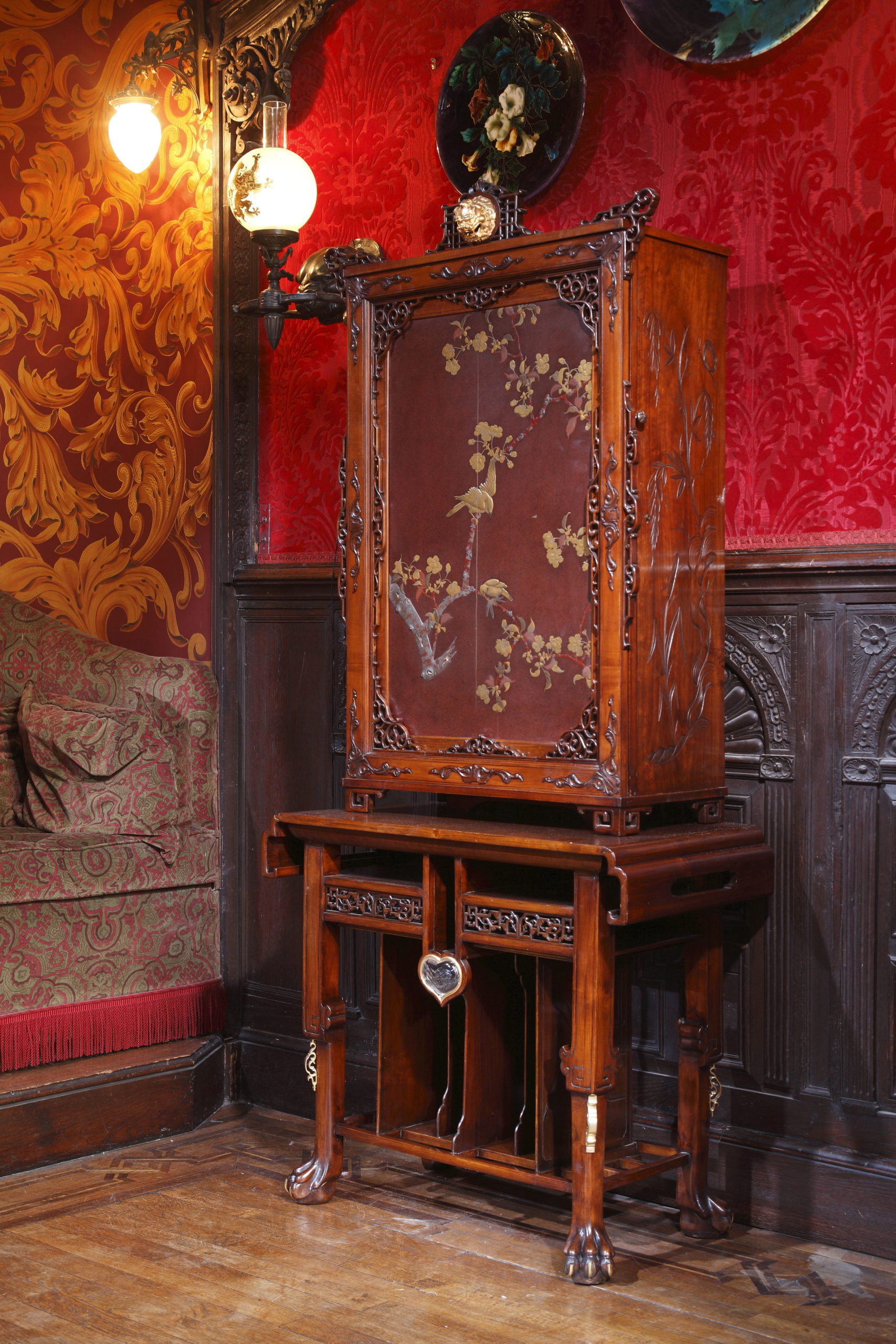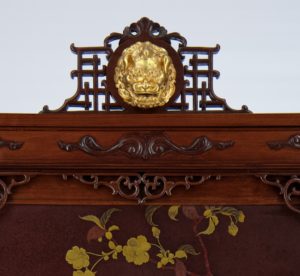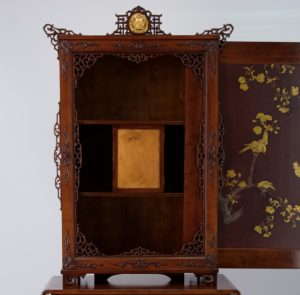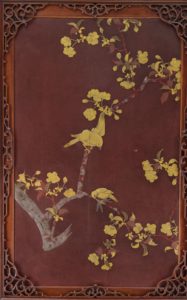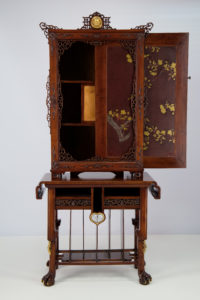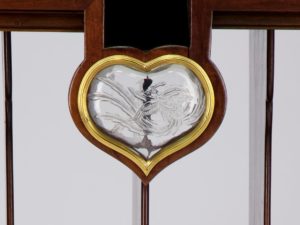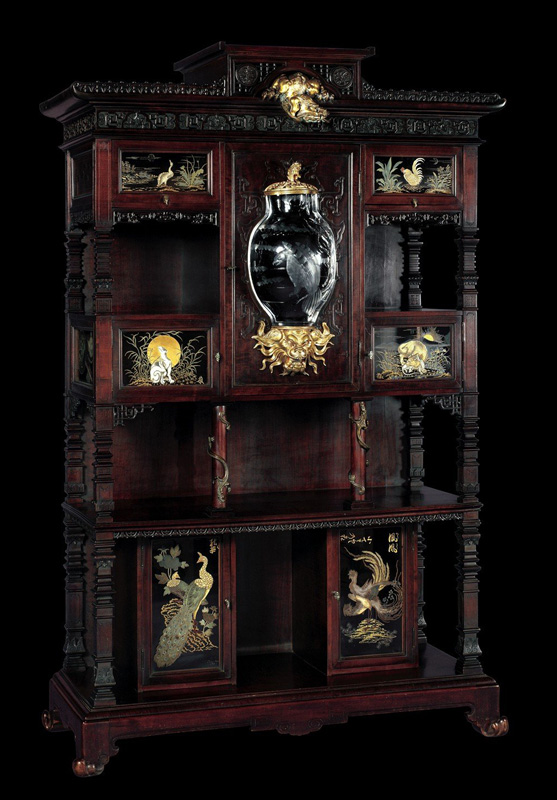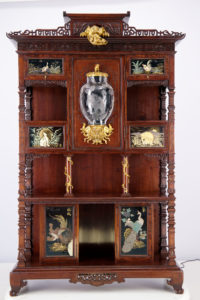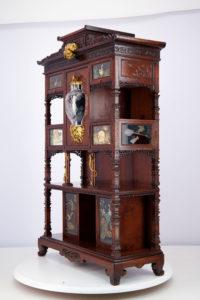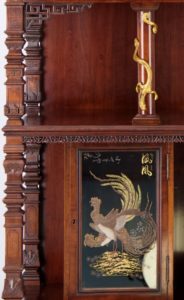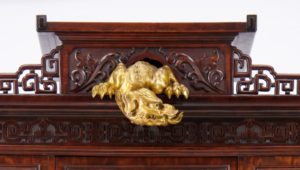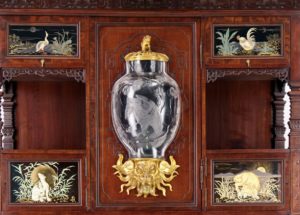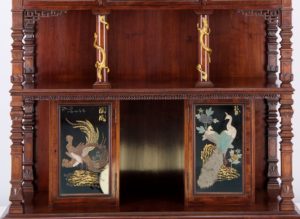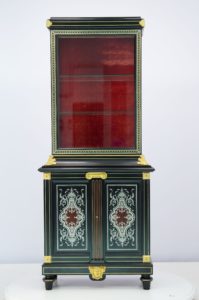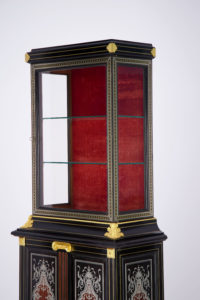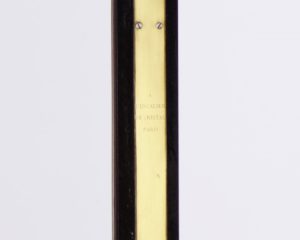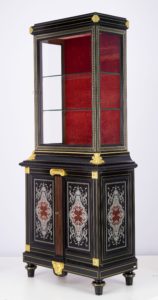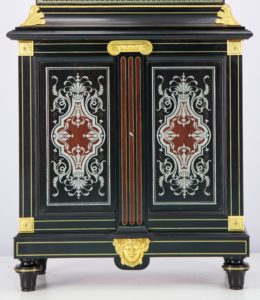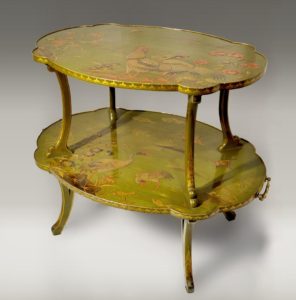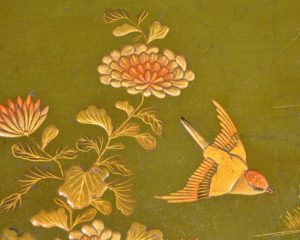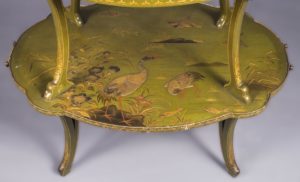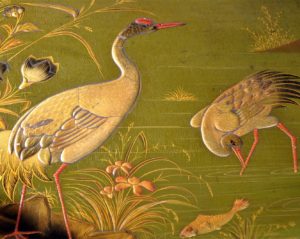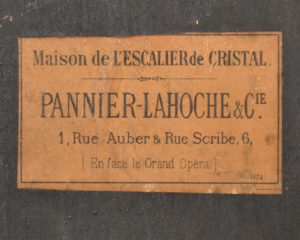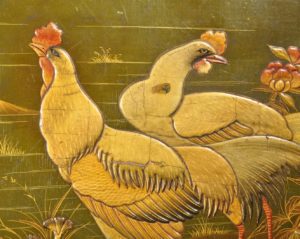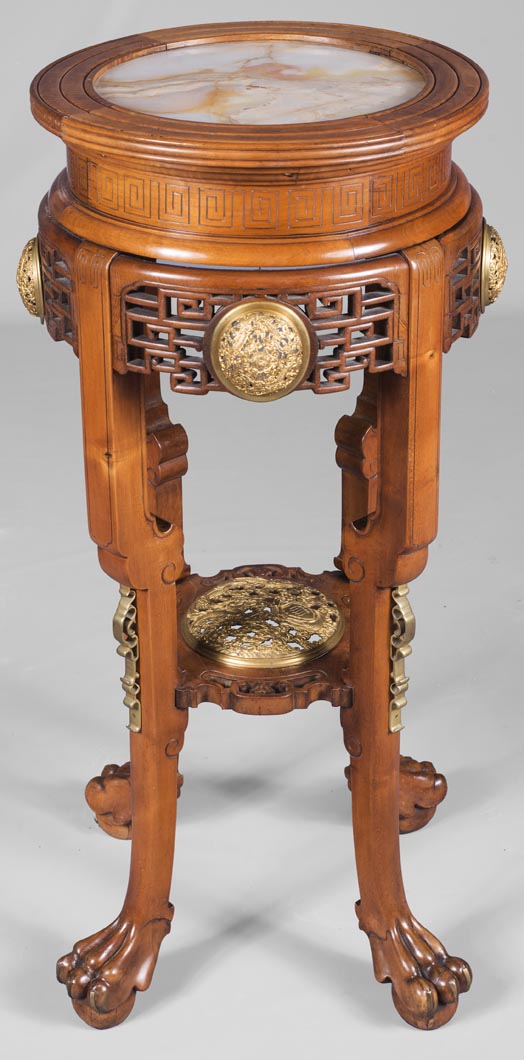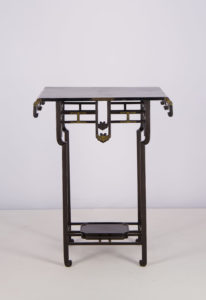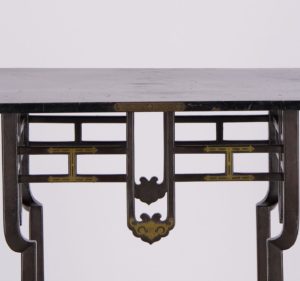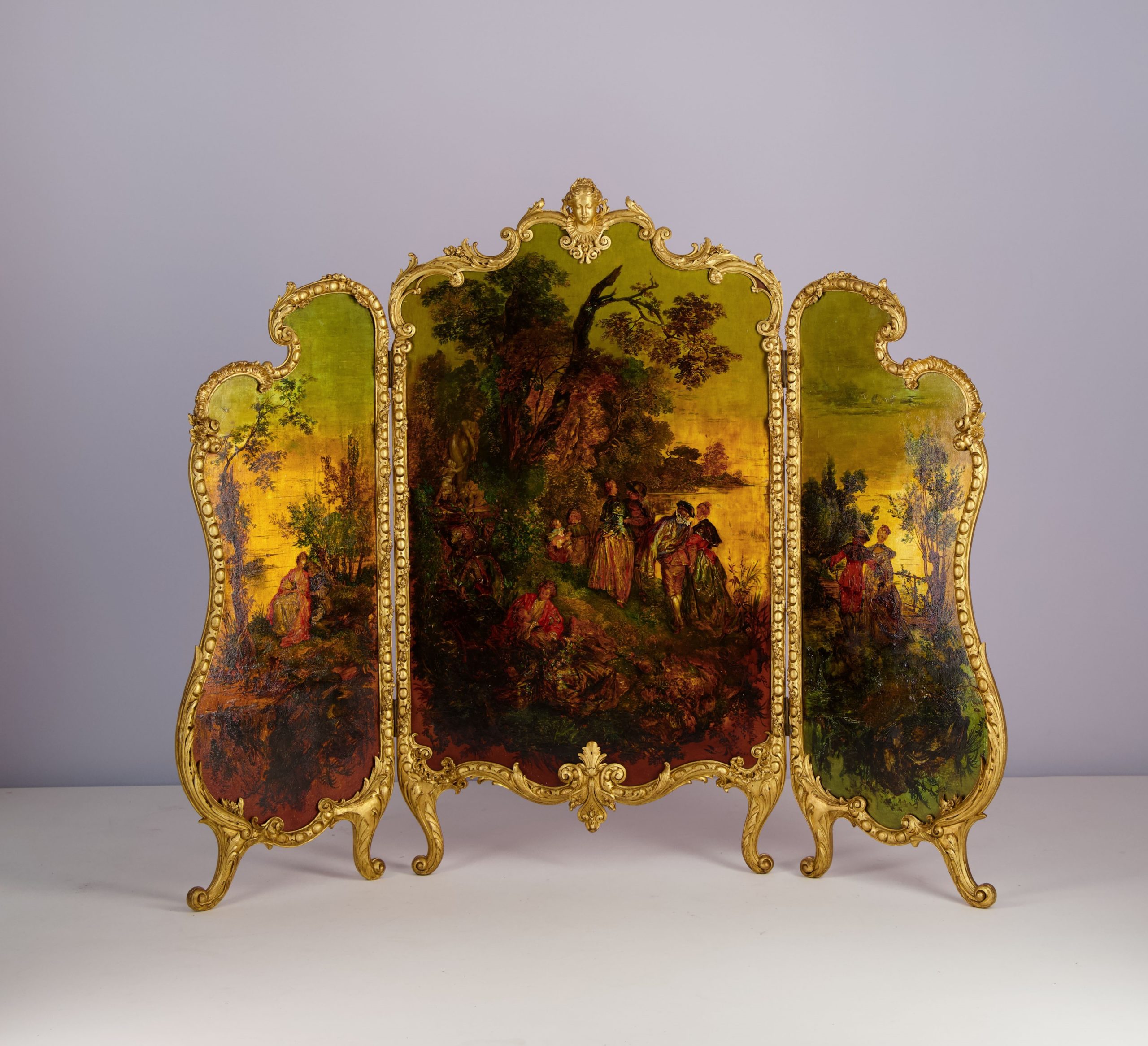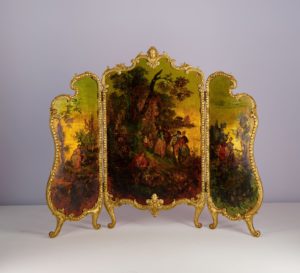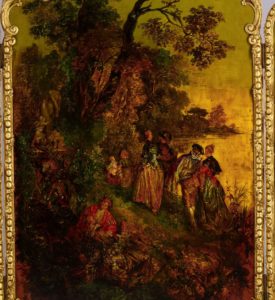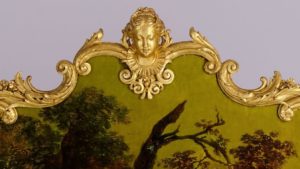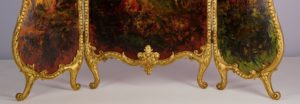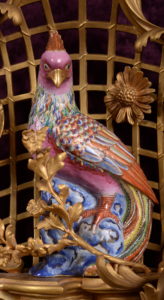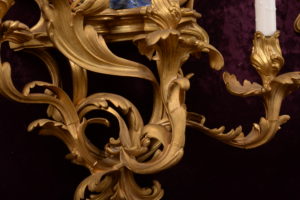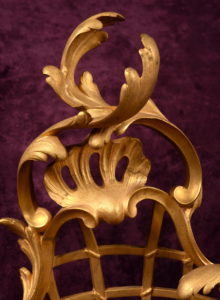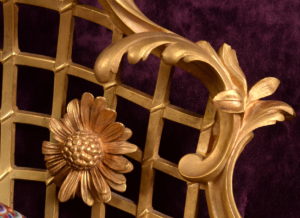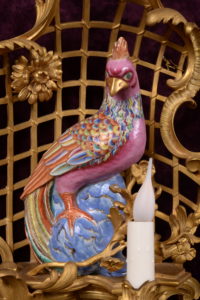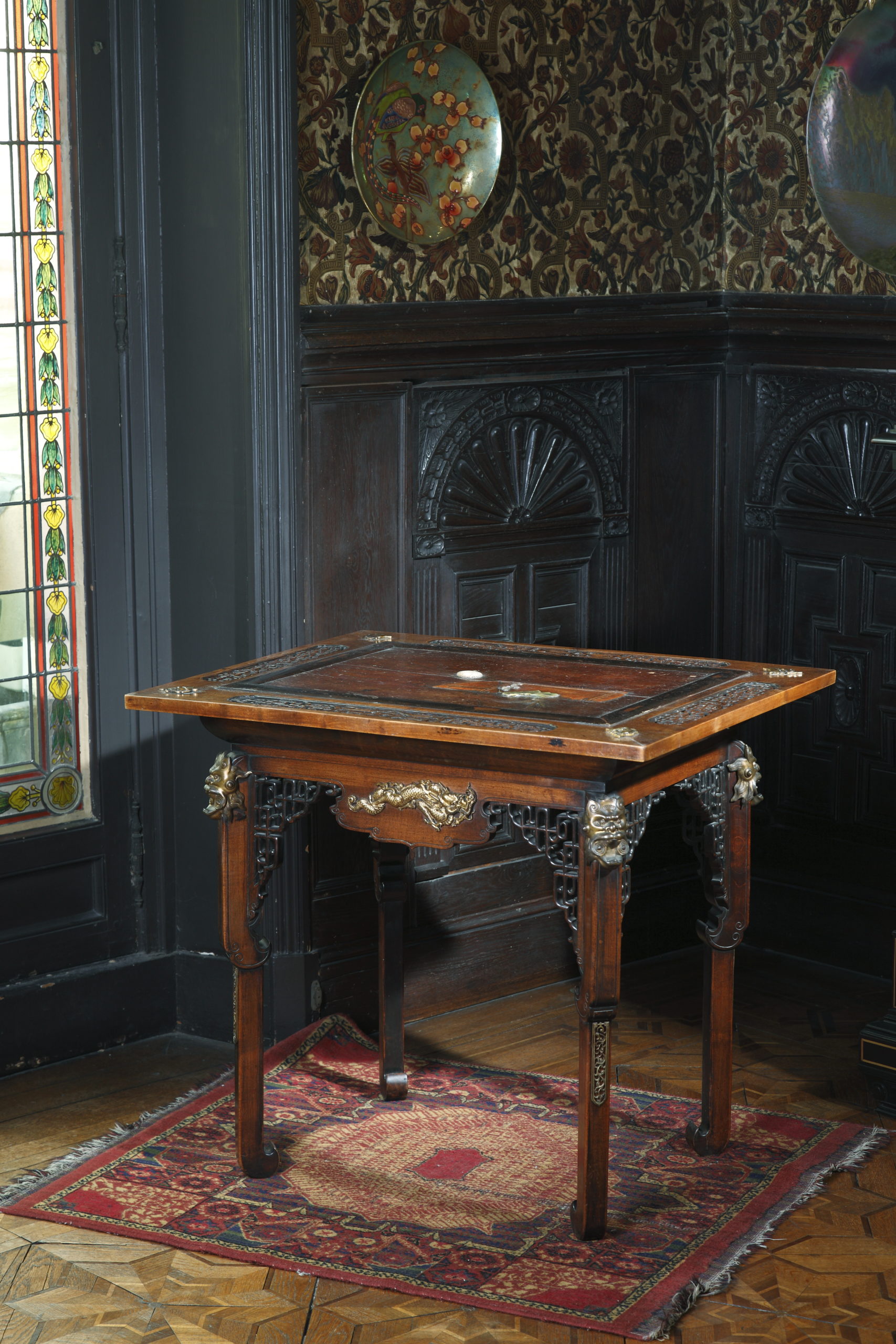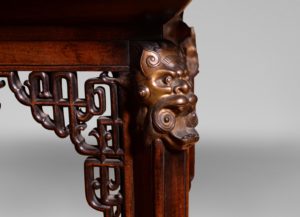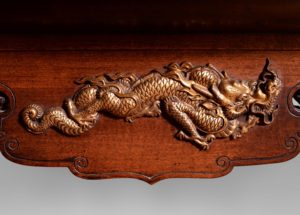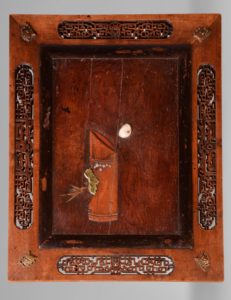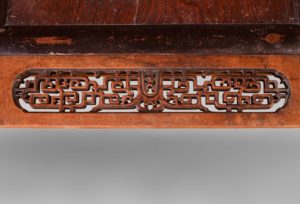The creation of furniture in the production of l’Escalier de Cristal did not appear until 1890 – with the exception of the dressing table of the Duchess de Berry kept at the Louvre.
Like most of the cabinetmakers of the late 19th century, the Pannier brothers produced a series of furniture imitating or inspired by the creations of the previous century. Nevertheless, it is the furniture of creation and inspired by Japanese fashion that attract our interest.
It seems necessary to emphasize the importance of the influence of Édouard Lièvre whose designs and models, sold during his sale after death in 1890, were acquired by the Pannier brothers.
We also note in Henry’s notebooks the repetition of certain well-known names of French Japanese creation such as Viardot or Majorelle, having made exclusive models of furniture for the store.
Drawing and mention in Henry Pannier’s notebook
Materials: Rosewood veneer, lacquer, bronze and crystal
Origin: France, after 1890
Dimensions: H: 180cm, L: 86cm D: 45cm
Furniture with sliding panel
This piece of furniture draws inspiration from its shape in Japanese architecture and furniture. It consists of a cabinet with a large Japanese lacquer panel decorated with floral motifs and gold-coloured birds. In order to remain faithful to the original inspiration, it does not open in the same way as a European door but in a sliding way adding a wink to the interior walls of traditional houses. The decoration that surrounds it consists of wooden lace with lines reminiscent also of an Far Eastern ornamental vocabulary. It rests on a base with overflowing sides adorned in the centre of a heart carved in crystal and framed in gilded bronze. We also find here and there on this piece of furniture gilded bronze ornaments above the claw feet and on the pediment.

© Annick et Didier Masseau, L’Escalier de Cristal le luxe à Paris, Editions Monelle Hayot, 2021
The notebook of Henry Pannier tells us that this piece of furniture was made by the cabinetmaker Charbonnier in 5 copies. It is designated as follows: “Sliding lacquered panel cabinet (Charbonnier) Head bronze claws, heart crystal engraved at the foot”.
Shelf cabinet with plates and crystal vase
This piece of furniture forming a shelf is inspired in its form and decoration by Japanese architecture, including a characteristic pediment adorned with friezes sculpted with Sino-Japanese motifs. The shelf consists of eight enamelled crystal plates forming doors or drawer fronts, decorated with elegant animal and vegetable scenes inspired by prints by popular Japanese artists such as Hokusai (1760-1849). They frame an admirable half crystal vase, protruding at the centre of the piece, decorated with an engraved eagle also inspired by the prints, it is decorated with a lid in gilded bronze and surmounted a chimera head also in gilded bronze. We find the pattern of the chimera on the set of gilt bronze decorations: wrapping around the two sizes under the vase as well as in the center of the pediment.
This shelf is one of the most important pieces of the collaboration between Henry Pannier and Gabriel Viardot. Looking at the production of G. Viardot we see that there is no other furniture known to this day, besides this model, where the artist uses crystal to create a shape of half vase or enamelled crystal for the ornamentation of the facade. On the other hand, the ornamental bronzes in the form of chimeras, wrapped around the pillars or threatening, as is the case on the pediment, are characteristic of the cabinetmaker’s production. We can therefore deduce that there was an exchange of ideas between Henry Pannier and Gabriel Viardot in order to imagine a Japanese piece of furniture showing absolute creativity.
Gabriel Viardot for L’Escalier de Cristal, Shelf furniture with plates and crystal vase, circa 1890
Preserved at the Corning Museum of Glass
Two exemplaries know
The notebook of Henry Pannier tells us that this piece of furniture is a model of Gabriel Viardot which was made in 3 copies. It is designated as follows: “Furniture (mod.Viardot) plates crystal 1/2 lobed vase eagle bronze cover chimeras bronze bronze coiled columns support the vase bronze chimera bronze head at the top”.
Today, only two of the three products have been found, ours and the one at the Corning Museum of Glass. Nevertheless, there are slight differences between the two pieces of furniture. Indeed, the two doors at the bottom, with a decoration of peacocks and another of cocks, are inverted on the two pieces of furniture. Moreover, the patterns of the friezes on the pediment are not exactly identical.
Signed “à l’Escalier de Cristal Paris”
Materials: Oak, ebony veneer, copper, pewter, gilt bronze, glass
Origin: France, after 1890
Dimensions: H: 166cm, L: 71cm D: 37cm
Louis XIV style display cabinet
Composed of a display case in the upper part in which two glass shelves stand out on a crimson background, and a body opening to two doors in the lower part, our furniture is decorated with a revival of the famous marquetry Boulle made famous by the cabinetmaker eponymous Charles-André Boulle (1642-1732). Very popular at the end of the seventeenth century, it experienced a revival under the Second Empire.
The marquetry is repeated on both doors and on the sides of the lower part, where a decoration of polished pewter and rosewood arabesques adorns the facades. The two panels are separated in the centre by the imitation of a column with grooves in rosewood marquetry and copper threads, while the ionic capital is carved in gilded bronze. The column surmounts a finely chiseled mascaron in gilded bronze. We find the use of this material in each of the angles of the facade taking the form of a square rosette. The window is also framed by an elegant frieze of marquetry. Finally, the straight lines of our furniture resting on top feet, are underlined by copper threads.
In addition to bearing the signature of the house inside the door, our furniture is also featured in Henry Pannier’s notebooks under the name “Petite vitrine L.XIV marquetry Boulle oak and copper thread”
Tea table with Martin varnish
Featuring a classic shape for this type of living room furniture, the great originality of this table lies in its decor, made in Vernis Martin. This technique was invented in the 18th century by the Martin Brothers who wanted to imitate the appearance of Japanese and Chinese lacquers, at a time when they were very rare in the West. After a relative disinterest in the first half of the 19th century, this technique returned to the taste of the day, particularly with the advent of fashion for the Far East and furniture by Louis Majorelle (1859-1926). In addition to the lacquer decoration, the decorative motifs on the two trays are unmistakably reminiscent of the Japanese and Chinese decorative repertoires: a pair of gallinaceae is located in a setting of blooming flowers and birds in full flight standing out on a series of mountains reminiscent of Mount Fuji. The lower plateau also plays this repertoire thanks to two cranes in a lake landscape inhabited by koi carp.
We know from Henry Pannier’s notebooks that Louis Majorelle made some furniture for the Cristal Staircase, so it is very likely that he also made our tea table characteristic of his production of furniture with Japanese decor.

Label “Maison de l’ Escalier de Cristal Paris Pannier Lahoche & Cie”
Materials: Wood and varnish Martin
Around 1890
Dimensions: H: 81cm, L: 95cm D: 69cm.
Label on the back of the marble : « Maison de l’ESCALIER DE CRISTAL PANNIER LAHOCHE & CIE 1 rue Auber & Rue Scribe 6 »
Materials : Walnut wood, giltbronze
Provenance : France, after 1890
Dimensions : H : 99cm
Chinese harness
This small harness inspired by the Chinese incense tables was made of walnut and is decorated with gold bronze medallions. The shelf placed in spacer presents a finely openwork decoration of far-eastern influence. In the centre of this tablet is a gilt bronze medallion, also openwork, and showing a decoration of chinese inspiration: a dragon and a turtle in clouds. Openwork grids also take place at the belt of this harness. In the center of each grid is placed the same type of medallion of gilded bronze, openwork and decorated with extreme-oriental motifs. The marble shelf is embedded in the wood.
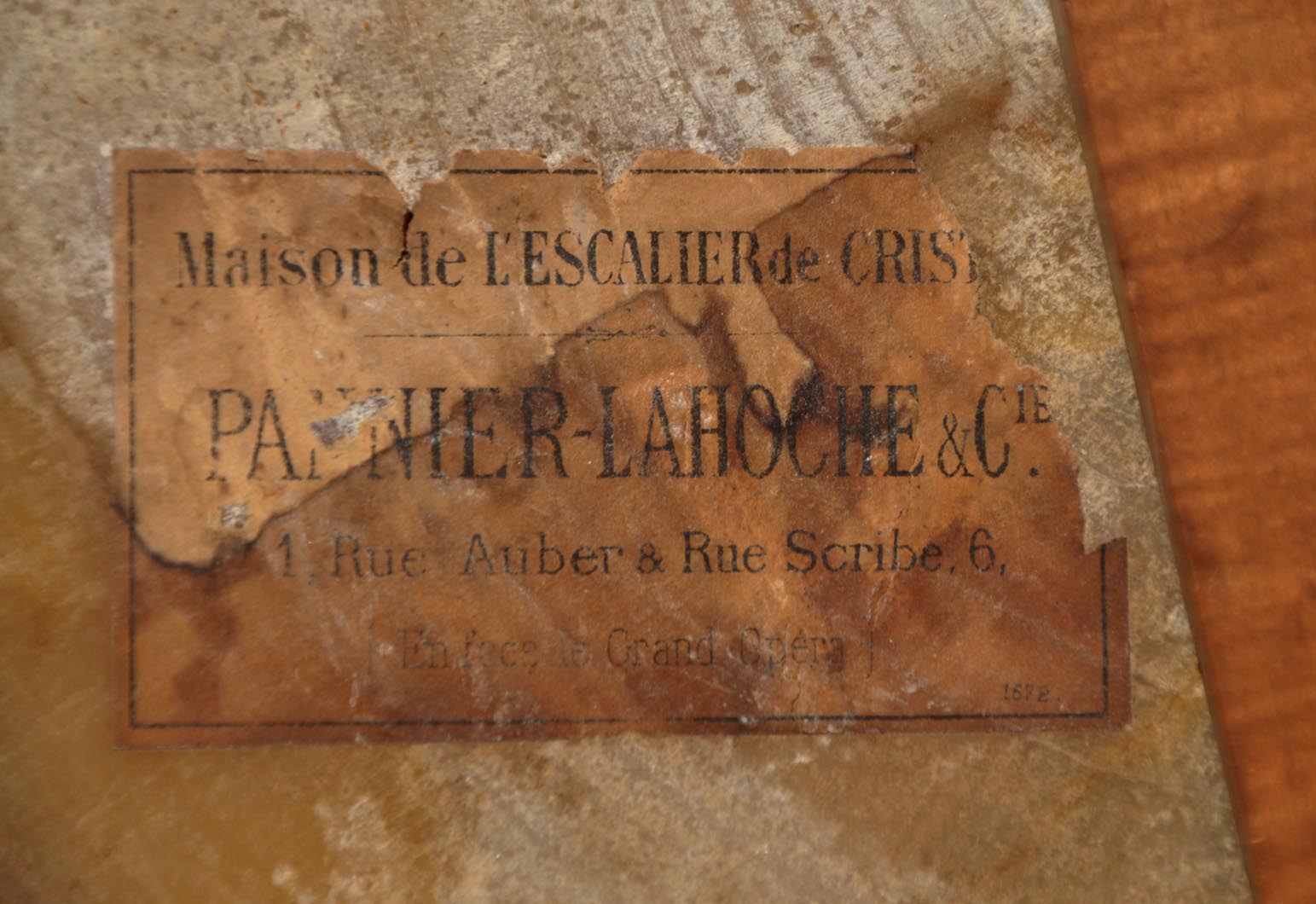
Small Japanese table
This small table stamped «Lanneau» was made of blackened wood at the end of the 19th century.
We do not know much about the life and work of Jean-Baptiste-Ange Lanneau (1824 – ?), except that the firm of cabinetmaking and seats was founded by Lanneau senior shortly before 1855 and that the last mention at Didot-Bottin dates from 1881. We also know that he participated in the Universal Exhibition of 1867 in class 14 – French furniture and that he won a silver medal for «Greek furniture and light chairs» and «whose seats are of a form both original and elegant.». Then at the Universal Exhibition in Vienna in 1873, where he won a medal of «good taste».

© Annick et Didier Masseau, L’Escalier de Cristal le luxe à Paris, Editions Monelle Hayot, 2021
Our table does not bear the signature of the Escalier de Cristal, but has a characteristic profile that can be recognized on one of the sketches of Henry Pannier’s notebooks. However, the name of the cabinetmaker and the wood species indicated do not match. Moreover, it is indicated that it is a model of Édouard Lièvre. We read “Foot mod Lièvre with bronze (Charbonnier) rosewood ” and we note that it was made in 11 copies.
Drawing and mention in Henry Pannier’s notebook
Materials : Gilt wood and lacquer Martin varnish
Provenance : France, after 1890
Dimensions : H : 130cm, L : 160cm
Louis XV style fireplace screen
Louis XV style recognizable by its moving lines and the winding ornamentations of its gilded wooden frame, our screen is original by the use of Vernis Martin for the decoration of the front faces. This technique was invented in the 18th century by the Martin Brothers who wanted to imitate the appearance of Japanese and Chinese lacquers. However, the decoration that adorns the lacquers on our screen remains faithful to the Louis XV style of the furniture and illustrates pastoral scenes in shady woods, rather than a decor inspired by the Far East.

© Annick et Didier Masseau, L’Escalier de Cristal le luxe à Paris, Editions Monelle Hayot, 2021
Our screen appears in the notebook of Henry Pannier where we learn that it was made by Louis Majorelle in 5 copies including one for the queen of Portugal and in small and large format. It is designated as follows: “Display 3 panels varnished Martin, back leather mount wood gilded L.XV (Majorelle)”
Louis XV style parrot wall lights
Imagined in the pure Louis XV style, our engraved and gilded bronze appliques feature moving lines giving pride of place to emptiness and fullness. The three arms of light, asymmetrically assembled, are formed by acanthus leaves wound and retained by a mesh niche with fretted contours. The latter decorated with stylized shells, flowers and acanthus leaves, serves as a cage for a porcelain parrot in shimmering colors reminiscent of the production of the Samson manufacture. These appliques were most certainly from their production since the notebooks kept by the family tell us that the Samsons worked for the Cristal Staircase in the late nineteenth and early twentieth centuries.
This dynasty of earthenware specialized in the reproduction of ancient porcelains of Saxony, China or Japan. The manufacture was a great success at the Universal Exhibitions of 1867 and 1889. In addition to porcelain manufacture and decoration, the Samson manufacture also had a bronze workshop for their frames.
Model attributed to Gabriel Viardot exclusively for l’Escalier de Cristal
Materials : Tainted sycamore teinté, lacquered panel and bronzes
Provenance : France, after 1890
Previously in the Marc Maison collection
Japanese table
This table does not possess stamp or label, nevertheless, it is important to underline the quality of execution. The choice of materials and the precision of the sculpture are typical of Viardot’s work who multiplies the decoration without being ever too much. Thus, this table was very likely made by Gabriel Viardot for l’Escalier de Cristal. Indeed, the quality of realization, the refinement of the decoration and the use of the same bronze decorations lead us to think that this furniture was made by the famous furniture maker, asked by l’Escalier de Cristal. More over, Viardot had a contract stipulating that he was supplier for some exclusive models for l’Escalier de Cristal.
This attribution was made thanks to the comparative study of the decorations bronzes.
